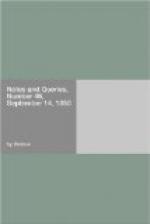the source of which some of your contributors have endeavoured to ascertain.
JAMES BLISS.
Ogbourne St. Andrew.
* * * * *
MINOR QUERIES.
The Spider and the Fly.—Can any of your readers, gentle or simple, senile or juvenile, inform me, through the medium of your useful and agreeable periodical, in what collection of nursery rhymes a poem called, I think, “The Spider and Fly,” occurs, and if procurable, where? The lines I allude to consisted, to the best of my recollection, of a dialogue between a fly and a spider, and began thus:— {246}
Fly. Spider, spider, what
do you spin?
Spider. Mainsails for a man-of
war.
Fly. Spider, spider, ’tis
too thin.
Tell me truly,
what ’tis for.
Spider. ’Tis for curtains
for the king,
When he lies in
his state bed.
Fly. Spider, ’tis too
mean a thing,
Tell me why your
toils you spread.
&c. &c. &c.
There were other stanzas, I believe, but these are all I can remember. My notion is, that the verses in question form part of a collection of nursery songs and rhymes by Charles Lamb, published many years ago, but now quite out of print. This, however, is a mere surmise on my part, and has no better foundation than the vein of humour, sprightliness, and originality, obvious enough in the above extract, which we find running through and adorning all he wrote. “Nihil quod tetigit non ornavit.”
S.J.
A Lexicon of Types.—Can any of your readers inform me of the existence of a collection of emblems or types? I do not mean allegorical pictures, but isolated symbols, alphabetically arranged or otherwise.
Types are constantly to be met with upon monuments, coins, and ancient title-pages, but so mixed with other matters as to render the finding a desired symbol, unless very familiar, a work of great difficulty. Could there be a systematic arrangement of all those known, with their definitions, it would be a very valuable work of reference,—a work in which one might pounce upon all the sacred symbols, classic types, signs, heraldic zoology, conventional botany, monograms, and the like abstract art.
LUKE LIMNER.
Montaigne, Select Essays of.—
“Essays selected from
Montaigne, with a Sketch of the Life of
the Author. London.
For P. Cadell, &c. 1800.”
This volume is dedicated to the Rev. William Coxe, rector of Bemerton.
The life of Montaigne is dated the 28th of March, 1800, and signed Honoria. At the end of the book is this advertisement:—
“Lately published by
the same Author ‘The Female Mentor.’ 2d
edit., in 2 vols. 12mo.”
Who was Honoria? and are these essays a scarce book in England? In France it is entirely unknown to the numerous commentators on Montaigne’s works.




